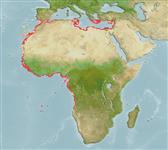Common names from other countries
Klassifizierung / Names
Namen | Synonyme | Catalog of Fishes(Gattung, Arten) | ITIS | CoL | WoRMS | Cloffa
Environment: milieu / climate zone / depth range / distribution range
Ökologie
seewasser demersal; tiefenbereich 90 - 220 m (Ref. 5222). Subtropical; 37°N - 16°S, 19°W - 37°E (Ref. 5222)
Eastern Atlantic: Mediterranean to southern Angola.
Size / Gewicht / Alter
Maturity: Lm ? range ? - ? cm
Max length : 125 cm TL Männchen/unbestimmt; (Ref. 111103); max. veröff. Gewicht: 25.0 kg (Ref. 5222)
Rückenflossenstacheln (insgesamt) : 11; Rückenflossenweichstrahlen (insgesamt) : 14 - 15; Afterflossenstacheln: 3; Afterflossenweichstrahlen: 9. Distinguished by the following characteristics: dark brown head and body color; soft dorsal, caudal and anal fins blackish distally, basal part lighter; white edge on caudal and pectoral fins; blackish pelvic fins; black streak on cheek at the upper edge of maxilla; depth of body contained 2.4-2.8 times in SL; head length 2.2-2.4 times in SL; convex interorbital area; subangular preopercle, with enlarged serrae at the angle, lower edge with 1-6 small serrae; posterior nostrils 2-3 times larger than anterior nostrils; maxilla naked, not reaching posterior to eye; 2 rows of teeth on midlateral part of lower jaw, inner teeth distinctly larger than outer teeth (Ref. 89707).
Deep-water species. Occurs on mud, sand, or rocky bottoms (Ref. 89707).
Life cycle and mating behavior
Maturities | Fortpflanzung | Spawnings | Egg(s) | Fecundities | Larven
Heemstra, P.C. and J.E. Randall, 1993. FAO Species Catalogue. Vol. 16. Groupers of the world (family Serranidae, subfamily Epinephelinae). An annotated and illustrated catalogue of the grouper, rockcod, hind, coral grouper and lyretail species known to date. Rome: FAO. FAO Fish. Synop. 125(16):382 p. (Ref. 5222)
IUCN Rote Liste Status (Ref. 130435)
CITES (Ref. 128078)
Not Evaluated
Bedrohung für Menschen
Harmless
Nutzung durch Menschen
Fischereien: weniger kommerziell
Tools
Zusatzinformationen
Download XML
Internet Quellen
Estimates based on models
Preferred temperature (Ref.
115969): 14.2 - 17.1, mean 15.6 (based on 37 cells).
Phylogenetic diversity index (Ref.
82804): PD
50 = 0.5001 [Uniqueness, from 0.5 = low to 2.0 = high].
Bayesian length-weight: a=0.01148 (0.00653 - 0.02018), b=3.05 (2.91 - 3.19), in cm Total Length, based on LWR estimates for this species & Genus-body shape (Ref.
93245).
Trophic level (Ref.
69278): 4.0 ±0.7 se; based on size and trophs of closest relatives
Widerstandsfähigkeit (Ref.
120179): sehr niedrig, Verdopplung der Population dauert mehr als 14 Jahre. (Preliminary K or Fecundity.).
Fishing Vulnerability (Ref.
59153): High to very high vulnerability (75 of 100).
